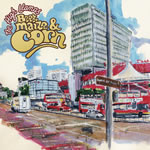|
|
 |
Dusted Reviews
Artist: The High Llamas Album: Beet, Maize & Corn Label: Drag City Review date: Oct. 2, 2003 |

|
|
|
 |
Inertia. That’s one major thing missing from the High Llamas’ newest long-player, Beet, Maize & Corn. It all starts off well enough, but within three minutes the whole enterprise just becomes a dragging mush of beautiful, yet somewhat overwrought, strings, near-identical sounding vocals, and acoustic guitars…and very little drumming. The damned record just doesn’t move: it plods along at its own happy pace.
Sean O’Hagan took a different route on this release, and it yields mixed results, to be sure. He decided to forgo bleeps and bloops and Wrecking Crew-ish drums for sturdy orchestral arrangements and, well, very little drums at all. By all accounts, emphasizing organic instruments over the electronic tics of the last few releases should be a good thing, and, in terms of atmosphere, he definitely succeeds. And one can’t help but be thankful that O’Hagan has somewhat dropped his Pet Sounds meets James Bond routine, which, after Hawaii alone, was a tad overdone, as astounding a recording achievement that record was. He has always worshipped at the altar of Brian and Burt (Wilson and Bacharach, if you’re nasty), and on this album, Burt clearly wins out in terms of tone and style. Too bad, O’Hagan forgot to bring along Bacharach’s clarity of melody and structure. What sunk in over the course of listening to this album was that the electronic accoutrements of the last few releases – retro though they were – helped push the High Llamas toward a more original, less pop-traditionalist, sound that’s completely abandoned here.
And this is pop music, right? Why is it all so damned unmemorable? One of the central tenants of pop music, at least in my opinion, is its hummability, its immediacy. These tunes go down easily, but they never stick to your ribs. O’Hagan’s abandonment of traditional song structure has a lot to do with this. One thing that Mssrs. Wilson and Bacharach had going for them was innovation within the verse-chorus-verse format. O’Hagan seems to stray from traditional pop song structure because he thinks it’s interesting, but what he doesn’t realize is that his favorite forebears worked with and mutated pop song structure while still retaining catchiness. By refusing to embrace some semblance of traditional pop form or at least bravely attempting to create something new with it, his album resolutely avoids hooks of any kind throughout its fairly brief duration. Thankfully, O’Hagan keeps with his more recent tradition of succinct records (think Buzzle Bee), but Beet, Maize & Corn still feels a little long.
Don’t get me wrong: What’s here is frequently beautiful. O’Hagan is a champ arranger (as evidenced by his work with Stereolab et al.), and he wields the orchestra with aplomb, though the strings are very out front and can often be a little distracting. He makes some ballsy decisions that mostly pay off (no sticking to the root chords here), but an occasional note or two does seem rather odd, given the pop formalism, however unstructured, of the proceedings. For the majority of its length, Beet, Maize & Corn wallows in the same Nick Drake meets Donovan pastoral beauty that Welsh fellow travelers Gorky’s Zygotic Mynci have been mining for the past few releases. There are gentle bossanova touches on “Calloway” and “The House of Leaf and Lime”, whose lyrics read kind of like a sea shanty. Overall, the lyrics are perfectly pleasant, but nothing is particularly grabbing. By the time one gets to the third track, “The Click And The Fizz”, a definite pattern has emerged: cue the strings, add some horns or piano, cue the acoustic guitar, maybe add some light drumming, take an unexpected songwriting turn, have a weird break, do something else with the strings, and voila! You have Beet, Maize & Corn. Strangely, the instrumentals are the most successful songs here.
I shouldn’t be so hard on this album. It is absolutely listenable and frequently gorgeous. I guess I just expect more from someone who is such a great arranger and composer. I let Plush get away with this same sort of thing, but I’m holding the fire to the High Llamas. I remember most of Gideon Gaye, but I’ve listened to this thing at least 20 times from beginning to end, and I still have trouble finding its center, its soul. The problem is institutional: O’Hagan seems frequently mired in the realm of emulation rather than innovation. It’s funny – now that he’s given us “innovation,” I kind of want emulation back.
By Lucas Jensen
|







